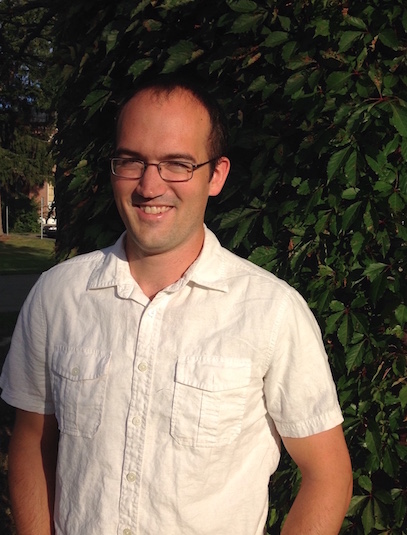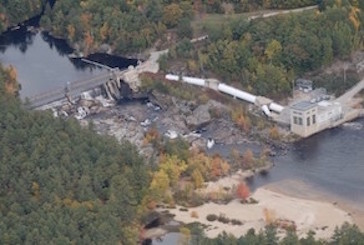Rising to the Surface for Sustainability Solutions
Postdoctoral researcher Sam Roy is looking up as he looks ahead
By David Sims
Sam Roy spent the bulk of his graduate years submerged in the deep time of geology. Then, as a postdoc in search of a career, Roy encountered the sustainability solutions mission of the Mitchell Center, which helped thrust him upwards toward work that might matter more to the future of the planet and its earthly inhabitants.
“I’ve just come up to the surface,” says Roy, now a postdoctoral researcher on the Mitchell Center’s National Science Foundation-funded Future of Dams project.
That Roy chose to downshift from work that was lofty and theoretical to that aimed at hammering out real-world solutions to complex sustainability problems was a short, evolutionary process but one that put him on a radically different path.

“The type of research for the postdoc positions I was applying to was very bookish,” Roy says. “The work was interesting and critical in terms of ground-breaking science, but during that application process I kept going to the Mitchell Center seminars and meeting with people there and I was immediately attracted by how much they were working directly with people and working on solutions to problems.” He adds, “That, and realizing I could actually be a part of the process while still contributing to scientific knowledge, is what attracted me the most. I was sold.”
“I kept going to the Mitchell Center seminars and meeting with people there.. I was attracted by how much they were working directly with people and working on solutions to problems.” —Sam Roy
In making his decision, Roy turned down a three-year postdoc at the University of Melbourne, Australia doing continental-scale geodynamic modeling and a two-year joint position between Tulane University and the University of Colorado Boulder developing the new standard in coupled landscape evolution modeling.
“By accepting your offer of the postdoctoral position,” Roy wrote in his letter to Mitchell Center director David Hart, “I feel that helping to develop a coupled social-ecology systems model for decision support will be a more rewarding and fruitful endeavor than working in a purely theoretical or physical capacity.”
The Future of Dams, a tri-state collaborative project between Maine, New Hampshire, and Rhode Island EPSCoR (Experimental Program to Stimulate Competitive Research) programs, aims to build stronger connections between science and decision-making about a number of potential dam options, including maintaining existing hydropower dams, expanding hydropower capacity, and removing aging dams to restore fisheries or reduce safety risks. By examining economic, environmental, and social tradeoffs, the project will help individuals and communities make better decisions about dams.
Trained in fluid dynamics, Roy’s role in the Future of Dams project will involve, for example, figuring out what a dammed river might look like under different scenarios such as dam removal or modification to allow fish passage.
“Part of that would be based on past work I’ve done in hydrology, which may allow us to figure out what flow conditions are like within the river—how the riverbed may evolve—with the removal or modification of a dam,” Roy says. He adds, “Additionally, I hope to work with Joe Zydlewski on fish passage issues and help him with hydraulic modeling for fish passage.” Zydlewski, who specializes in the physiology, behavior, and ecology of migratory fish, is one of six UMaine researchers, as well as one from the University of Southern Maine, on the project.
Roy’s first encounter with Mitchell Center sustainability work was on a sister project to the Future of Dams—the Safe Beaches and Shellfish project. Both projects are part of the multi-institutional New England Sustainability Consortium designed to respond to societal challenges where economic and community development goals need to be balanced with environmental protection.
Roy credits Safe Beaches and Shellfish researcher Sean Smith, assistant professor at the UMaine School of Earth & Climate Sciences and the Mitchell Center and a member of Roy’s Ph.D. committee, with encouraging him to expand his focus from things in the geologic realm towards matters on shorter timescales.
“Sean helped me to realize the need to study rivers over multiple timescales, that it can take thousands to millions of years to shape a landscape, but this is done incrementally over storm events that occur at the same short timescales on which rivers and humans interact,” Roy says. And that, of course, is part and parcel to both the Future of Dams and Safe Beaches and Shellfish projects.

A Maine boy steeped in rocks and rivers
Roy grew up in Oakland, Maine, majored in geology at UMaine and eventually earned his doctorate in the School of Earth and Climate Sciences in 2015. His father, he says, was responsible for instilling in him a love of geology and rivers—both of which laid the foundation for his educational career and, now, professional work.
“I love rocks and that’s mostly because of my dad. Growing up we’d go to quarries in western Maine together and find tourmaline and muscovite, all these interesting looking minerals,” Roy recalls. “And he and I would also take a lot of canoe river trips and I came to love rivers and the Maine landscape. I’ve always been interested in Earth evolution as a whole so I kind of went that way and have been lucky enough to follow my geological passion as well as, now, rivers.”
Roy was brought into the Safe Beaches and Shellfish project as a research associate to help figure out—using his fluid mechanics/hydraulic modeling skills—if there are specific conditions in a watershed that can create higher potential for contamination by fecal bacteria, which can close shellfish beds for weeks at a time.
“For the project, which just reached a major milestone, we were interested in a smarter approach to shellfish regulations, which includes a default closure of clam flats based on the occurrence of two inches of rainfall in a 24-hour period,” Roy says. He adds, “So, from the watershed/river perspective we wanted to see if we could figure out what kind of flow conditions actually occur after two inches of rainfall and determine if it truly has a significant and broad influence on the condition of the clam flats.”
The hydraulic modeling Roy did for the project was an effort to construct a “decision support tool” that could be used by the Maine Department of Marine Resources (DMR), which regulates the shellfish beds and makes the call on closures, to more accurately gauge when and where closures should occur.
Says Roy, “If we can use this tool to figure out if the flushing of an estuary happens faster than the default two-week period and, for example, coliform levels drop to safe levels within 10 days rather than a full two weeks, the clam flats could safely be reopened and that would be a potential economic boon for the shellfishermen.” Roy notes that the DMR, too, would save time, effort, and money since during the mandated two-week period water samples have to be gathered to help determine the coliform bacteria levels from a variety of estuaries/clam flats.
The hydrology component of the decision support tool, which Roy designed to make predictions of fluid (water) flow for 535 watersheds in the Gulf of Maine for any given storm scenario, is now in the validation stage. The model is good for understanding surface water flow, and the fecal coliform contaminants are a part of that flow, “but the model I’ve produced doesn’t actually model the life stage of bacteria within the freshwater column. It’s an approach to better understand the transport of fecal coliform but not actually modeling the bacteria themselves, so there still needs to be some statistical validation,” Roy explains.
Modeling for what’s at stake
Roy says the link that was forged between the Safe Beaches and Shellfish project and his current work with the Future of Dams was, for him, the new component of working directly with people who are not part of the academic research per se but have much at stake in the work being carried out—stakeholders.
“Safe Beaches and Shellfish allowed me to learn the fundamentals of working with stakeholders for the first time…”
—Sam Roy
“The Safe Beaches and Shellfish project allowed me to learn the fundamentals of working with stakeholders for the first time and, because I was studying Maine rivers as part of the decision support tool modeling work, that gave me a head start in this project just getting underway,” Roy says. He adds, “Many of the rivers I studied for Safe Beaches are ones we’re focusing on now, especially the Penobscot and Kennebec, so that provides a fairly easy transition.”
Part of the new work collaborating with stakeholders will be Roy’s immersion in what’s known as “participatory modeling” techniques, which, essentially, involves building a model with direct involvement of project stakeholders.
“It’s very new to me but it seems to have caught fire in sustainability science in the last five to ten years,” says Roy. He believes participatory modeling is probably one of the best ways to get input from stakeholders and build a good model in part because researchers get local, relevant information that could improve the model while it’s being built rather than handing stakeholders a black box after the fact and telling them to now give it a whirl.
Says Roy, “In participatory modeling, the stakeholders actually have a stake in the model because they’re helping to build it, which means they’re more likely to use it in the future, or improve upon it. So it’s a really a useful strategy.”
